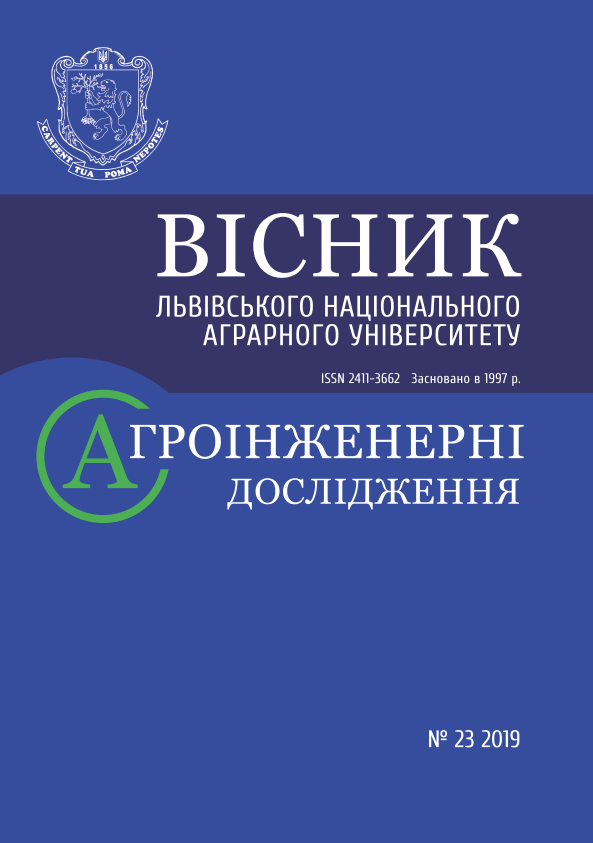ENERGY SUPPLY FOR THE PROCESSES OF GREENHOUSE BUSINESS WITH APPLICATION OF RENEWABLE SOURCES OF ENERGY
DOI:
https://doi.org/10.31734/agroengineering2019.23.056Keywords:
greenhouse, renewable energy sources, energy saving, automation, microclimate control systemAbstract
The article stresses that photosynthesis is a basis for the technological process of covered soil constructions used for growing of vegetables and flowers. The process is revealed in transformation of carbon dioxide into a marketable organic substance with oxygen release under the impact of light. Main factors of the production environment were analysed. To perform tasks of the technological process effectively, it is necessary to secure the best-possible levels of such principal parameters as air temperature in the greenhouse; temperature of the air outside (control); temperature of soil in the greenhouse; air humidity in the greenhouse; soil humidity in the greenhouse; concentration of carbon dioxide CO2 in the greenhouse; concentration of carbon monoxide CO in the greenhouse; level of lighting in the greenhouse; air velocity in the greenhouse. In addition, one has to ensure the continuous monitoring of following aspects: type and the total level of radiation; airspeed outside the greenhouse (control). The work notes that in the structure of production costs of a covered soil construction, a considerable share is taken by costs for energy sources. Hence, the system of energy supply for greenhouse business should be developed with application of renewable sources of energy referring to the approved structural scheme. In particular, it has been shown that the main renewable energy sources suitable for use in a greenhouse are wind and solar. An obligatory element of such energy system includes an automatic system of control for the parameters of greenhouse microclimate. Such solution will reduce costs for energy sources and improve ecological compatibility of production. It is also proved that the optimization of the structural scheme of the system of control and management of the microclimate parameters increases the level of reliability of the developed system, allows reducing the costs of its development and maintenance.
References
Avdzhyan, N., Kirichenko, A., Skorohod, A. (2016). Sozdanie neobhodimogo mikroklimata v teplitsah za schet ispolzovaniya vozobnovlyaemyih istochnikov energii. Aktualnyie problemyi energetiki APK: materialy VII mezhdunar. nauch.-prakt. konf. Saratov: TseSAin.
Bolotskih, N. (2015). Zarubezhnyie tehnologii infrakrasnogo obogreva teplits. Naukovyi visnyk budivnytstva, 1(79), 150–158.
Nadirov, N., Nekrasov, V., Shevchenko, S., Solodova, E., Suhanberdieva, D. (2016). Vozobnovlyaemaya energetika v teplichnyih tehnologiyah. Dokladyi Natsionalnoy akademii nauk Respubliki Kazahstan, 2, 137–144.
Ivanenko, V. (2011). Osoblyvosti formuvannia enerhovytrat na vyrobnytstvo produktsii ovochivnytstva zakrytoho gruntu. Naukovyi visnyk LNUVMBT im. Gzhytskoho, 2(48), 71–78.
Martynenko, I. (1995). Avtomatyzatsiia tekhnolohichnykh protsesiv silskohospodarskoho vyrobnytstva. Kyiv: Urozhai.
Nadirov, N., Nekrasov, V., Tanirbergenova, A., Yusupova, M. (2015). Teplitsyi – novyie resheniya v proizvodstve produktov pitaniya. Agrarnyiy sektor, 4. 89–93.
Nekrasov, V.G., Shevchenko, S.A., Yusupova, M. (2015). Energetika teplits (teplichnyie tehnologii). Berlin: LAMBERT Academuc Publishing.
State Statistics Service of Ukraine. (2018). Agrarian sector: statistical notes. Retrieved from www.ukrstat.gov.ua.
Tiravskiy, V. (2011). Parnikovyiy effekt. Status, 22(192). Retrieved from http://statuspress.com.ua/nisha/parnikovyj-effekt-2.html.
Anushree, M. K., Krishna R. (2018). A smart farming system using Arduino based technology. International Journal of Advance Research, Ideas and Innovations in Technology, 4(4), 850–856.
Shankaraiah, D., Prajwal, G., Hemanth Kumar B. S., Shweta B., Nayana, R. (2019). Automated green house. International Journal of Advance Research, Ideas and Innovations in Technology, 5(3), 1831–1834.
Eddahhak, A., Lachhab, A., Ezzine, L., Bouchikhi, B. (2007). Performance evaluation of a developing greenhouse climate control with a computer system. AMSE Journal Modelling, 68(1), 53–64.
Ganesan, K., Walele, U., Hambire, N., Choughule, P., Oommen, D. (2018). Raspberry-Pi Based Automated Greenhouse. International Research Journal of Engineering and Technology (IRJET), 5(3), 2346–2350.
Shamshiri, R. (2007) Principles of Greenhouse Control Engineering. Part 1: Theories & Concepts. ITMA, UPM.
Somvanshi, S., Pandey, D., Asthana, P. (2017). Monitoring System of a Greenhouse. International Journals of Advanced Research in Computer Science and Software Engineering, 7(6), 847–851.
Woodenergy. (2019). Enerhetychnyi monitorynh ta ekonomichna otsinka teplychnykh hospodarstv. Retrieved from https://green-house.at.ua/publ/energetichnij_monitoring_ta_ekonomichna_ocinka_teplichnikh_gospodarstv/1-1-0-4.


